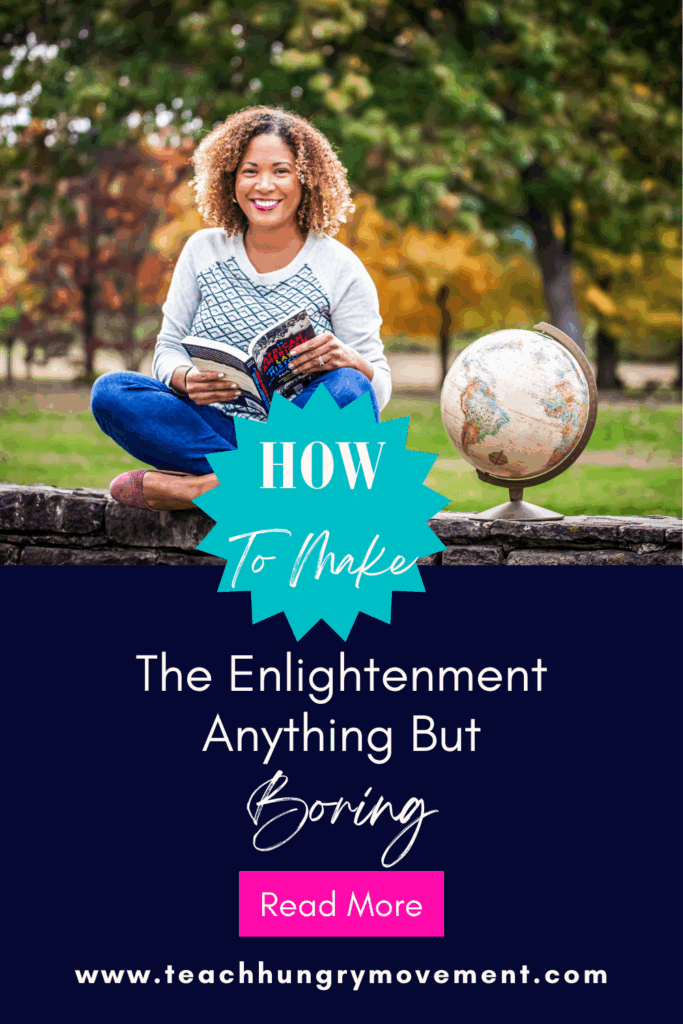When I first started teaching about the Enlightenment, I’ll admit, I struggled to make it stick.
The names, the ideas, the philosophes… it all felt so abstract.
The first time I tried, my students were more interested in if we’d get a snow day than Rousseau’s social contract.
Here’s the thing: the Enlightenment can be one of the most fascinating periods to teach. It inspired revolutions, governments, human rights, and social movements.
But it can also be painfully dry if it’s just a lecture filled with dates, French names, and quotes in old English.
Trust me, I’ve been there.
That’s why over the years, I’ve developed strategies to make the Enlightenment feel relevant. And even a little controversial (in a good way).
And, because social justice is part of history, I discuss inequality, human rights, and how they connect to students’ lives.

Let’s dive in.
Why Teaching the Enlightenment Can Be Tough
First, let’s be honest.
Most textbooks make the Enlightenment look like a giant, dusty philosophy catalog.
Locke, Hobbes, Rousseau, Voltaire…
Then there’s the French Revolution and the U.S. Constitution. We teach that they’re outcomes of these ideas, but rarely do students connect the dots in a meaningful way.
The danger is that students can leave class thinking, “Cool, some guys wrote some essays a few hundred years ago.”
And as teachers, we know that students need to see why it matters.
This is especially true if we’re trying to incorporate social justice angles.
The Enlightenment is often presented as a European phenomenon. And European men are the heroes.
But the ideas from this period had global implications.
Some inspiring positive change, some justifying exploitation and inequality.
If we ignore that tension, we’re missing an opportunity to teach critical thinking.
Here are some lesson ideas to get you started:
Related: Ultimate Social Studies Bundle – FREE
1. The Enlightenment Attitude Inventory
One of my favorite ways to kick off a unit is with an attitude inventory.
(If you’ve read my blog post about teaching New Immigration in U.S. History, you know I love an attitude inventory.)
It’s a “do you agree or disagree” sheet on ideas like human nature, the role of government, and social equality.
Here are a few sample statements:
- Humans are naturally selfish.
- Government is necessary to keep order.
- All people should be free and equal, without social hierarchies.
- Education is necessary to become virtuous and productive.
Students respond individually first, then discuss in small groups. The goal is to help them see their own assumptions, compare perspectives, and start thinking about the Enlightenment’s claims.
It’s a low-prep way to spark discussion. But it also sets the stage for connecting Enlightenment ideas to modern debates. Plus, it’s fun to watch students argue over whether “humans are naturally selfish.”
2. Contextualizing the Enlightenment
After the inventory, I like to move into contextualization. Students often think ideas exist in a vacuum. But every Enlightenment philosophe wrote in response to real-world problems.
- Hobbes lived through civil war. He argued for a strong central government because he believed humans are selfish and violent.
- Locke reacted to political instability in England. He advocated for natural rights and government by the consent of the governed.
- Rousseau considered the corruption of society and the loss of individual freedom.
By framing their writings within the historical context, students can see why these ideas emerged. Additionally, how they were meant to solve problems.
I also like to juxtapose these European thinkers with global issues of the time.
For example, Locke wrote about liberty & property, while the Transatlantic Slave Trade flourished. Bringing that tension into the conversation immediately makes students ask: who was included in “all men are created equal”? And who was left out?
Boom. Social justice connection made.

3. Making It Interactive: Salons and Debates
One of my absolute favorite activities is recreating a French Enlightenment salon.
Historically, these gatherings were where intellectuals debated society, government, and rights. I love having students take on the roles of different philosophes and engage in discussion.
Here’s how it works:
- Assign students a philosophe (Hobbes, Locke, Rousseau, Voltaire, Wollstonecraft, etc.).
- Have them research their philosophe’s views on:
- government
- human nature
- education
- women’s rights
- slavery
- colonization.
- Set up a “salon” where students discuss 18th century issues through the lens of their thinker.
It’s amazing to watch students argue as Voltaire about freedom of speech. Or channel Wollstonecraft on women’s education. You can even frame questions that force them to think about justice:
- Would your philosophe support abolishing slavery? Why or why not?
This activity is gold for teaching perspective-taking and critical analysis. Students are using the philosophe’s ideas to make judgments about right and wrong.
And yes, they also get a little theatrical and competitive, which is the fun part.
4. Linking the Enlightenment to Social Justice
If you want students to care about the Enlightenment, you have to make it relevant. I like to highlight both the promise and the blind spots of the period:
- Promise: Ideas about natural rights, education, equality, and government influenced several revolutions. These include the American Revolution, the Haitian Revolution, and movements in Latin America. These ideas were radical for their time and continue to inspire human rights struggles.
- Blind spots: Many Enlightenment thinkers didn’t apply these principles universally. Women, enslaved people, Indigenous populations, and colonized peoples were often excluded. Looking at these contradictions starts a conversation about inclusion, fairness, and whose voices matter.
A concrete example is the Haitian Revolution. Students can compare Locke’s or Rousseau’s ideas about slavery in Saint Domingue. Then they analyze how people applied Enlightenment ideas selectively. Followed by discussing how those choices connect to today’s social justice issues.
RELATED: How To Give The Haitian Revolution The Justice It Deserves
RELATED: Haitian Revolution Corroboration Activity – ELL-Friendly
5. Using Texts and Primary Sources
I’m a huge fan of using primary sources, but you have to be strategic. Dense Enlightenment texts are… well, dense.
Here’s a workflow I use:
- Start with excerpts, not entire treatises. Choose sections that directly relate to rights, government, or equality.
- Provide a “modern language” translation alongside the original text. For example, students can read a paraphrased version of Locke’s Two Treatises of Government. This will help them understand ‘natural rights’ and ‘consent of the governed’ better.
- Ask students to summarize each section in their own words. Then connect it to a contemporary issue.
Example activity: take Locke’s argument about government protecting life, liberty, and property. Have students discuss: Do governments today protect these rights for everyone? If not, who is excluded?
The combination of historical text and modern context helps struggling readers.
6. Adding Multimedia: Videos, Podcasts, and Images
Sometimes you need a break from the reading. Videos and podcasts are great ways to bring the Enlightenment to life. Especially if they tie to real-world issues.
- Crash Course World History has short, engaging clips on the Enlightenment and revolutions. I don’t show these in class. They talk way too fast for most students. When I use them I either use them as background information for myself, or I assign them as homework, so students come ready to discuss.
- Podcasts like Revolutions by Mike Duncan explain the American and Haitian Revolutions, and how the Enlightenment influenced them. Even if you don’t play them in class, you can summarize key points for students.
- Images of salons, revolutionary pamphlets, or early constitutions help students visualize the ideas.
You can even make it interactive: assign students an image or excerpt and ask them to answer, How does this represent Enlightenment ideas? Whose rights are protected? Whose are ignored?
7. Applying the Ideas Today: Contemporary Connections
The most powerful moments occur when students realize that these ideas are not just historical; they’re ongoing debates.
Here are some prompts I like:
- Look at a current government policy. Does it reflect the social contract? Are citizens’ rights protected?
- Consider education inequality. How would Rousseau feel about modern public schools?
- Debate free speech in the age of social media. How would Voltaire weigh in?
- Examine racial or gender inequities. Who is included when we say “all men are created equal”?
8. Strategies to Avoid the “Dry Lecture” Trap
If you want to prevent the Enlightenment unit from feeling like a slog, here are some strategies:
- Mix lecture with activities:
- Notes are useful for context, but students need discussion, debate, or partner work to process ideas.
- Use role-play and simulations:
- Salons, mock debates, and thought experiments make abstract ideas tangible.
- Encourage reflection:
- Ask students how their opinions change after a discussion or after reading primary sources. Reflection can be written or shared orally.
- Connect to contemporary issues:
- Don’t just talk about ideas in a vacuum; tie them to current events, social movements, or local issues.
- Provide choice:
- Let students select a philosophe or social justice issue to research. Ownership increases engagement.
9. My Favorite Activities for Social Justice Connections
Here are a few of my tried-and-true strategies:
- Enlightenment Bullseye:
- Students pick a key term from a philosopher’s work and connect it to historical events, contemporary issues, and universal themes.
- Philosophe Advice Project:
- Students choose a modern leader or political figure. Then they write advice from the perspective of their assigned philosophe. They justify their recommendations with historical reasoning.
- Declaration of Independence Contextualization:
- Students analyze the document using Enlightenment ideas. Then they discuss whose rights were excluded, comparing it to today’s struggles for equality.
- Candide Analysis:
- Using Voltaire’s satire, students explore contradictions in Enlightenment thinking. Plus, they discuss ethical dilemmas, like exploitation and human suffering. (This is a challenging activity that I use exclusively with my honors-level students.)
- Salon Discussions:
- As mentioned above, role-playing philosophers allows students to explore debates on:
- rights
- governance
- education
- slavery,
- colonization
- As mentioned above, role-playing philosophers allows students to explore debates on:
Final Thoughts
Teaching the Enlightenment doesn’t have to be dry or dusty. By using activities, primary sources, and social justice topics, you can make this interesting and relevant
Here’s what I’ve learned over the years:
- Students are capable of deep analysis if you give them the right tools and context.
- Connecting ideas to the modern world makes abstract philosophy meaningful.
- Discussing the limits of Enlightenment thinkers starts important conversations about fairness and justice.
- History is messy, contradictory, and full of tension. Embracing that is more engaging than oversimplification.
If you leave your students with just one thing, let it be this: the Enlightenment isn’t just about long-dead philosophers. It’s about ideas that challenge power, shape governments, and inspire movements for justice.
And those ideas are still alive today.
In case you missed them:
Grab: Ultimate Social Studies Bundle – FREE
Don’t forget: How To Give The Haitian Revolution The Justice It Deserves
Lesson Plan: Haitian Revolution Corroboration Activity – ELL-Friendly
+ show Comments
- Hide Comments
add a comment